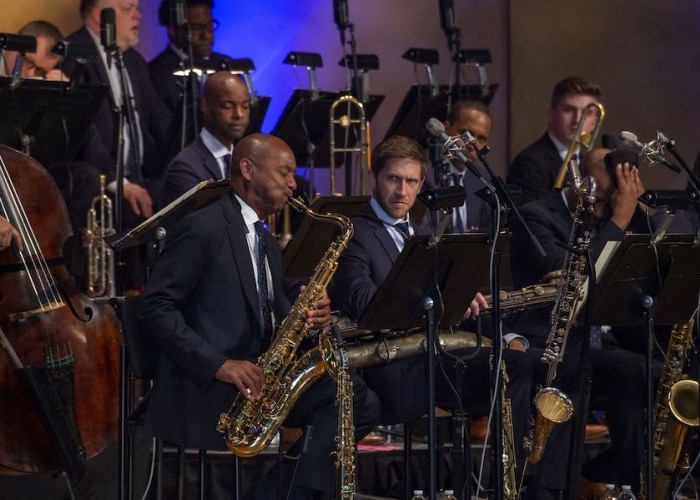Oct 28, 2025 10:47 AM
In Memoriam: Jack DeJohnette, 1942–2025
Jack DeJohnette, a bold and resourceful drummer and NEA Jazz Master who forged a unique vocabulary on the kit over his…

Branford Marsalis played the featured soloist role for JLCO’s tribute to John Coltrane and Sonny Rollins at Ravinia.
(Photo: Courtesy the Ravinia Festival)Jazz returned to the Ravina Festival in Highland Park, Illinois, in late July following the silent summer of 2020. The honors were done by the Jazz at Lincoln Center Orchestra, which presented three extended works plus an encore demanded by an enthusiastic crowd that filled more than three quarters of the 3,350-seat pavilion. Beyond that, a large crowd picnicked, partied and listened on the venue’s lawn.
Ravinia attracts large, general-interest audiences with a mixture of Chicago Symphony concerts and big-name pop nostalgia. Jazz presentations have moved increasingly to the margins in recent years as its marquee stars of yesteryear have retired or passed on.
Still, for venues like Ravinia, the JLCO is the perfect bridge across that gap of mortality. In representing the work of musicians from Louis Armstrong to Ornette Coleman, it puts jazz history on the marquee and offers a comforting element of familiarity to many.
For this performance, the ensemble focused particularly on Sonny Rollins and John Coltrane. Artistic Director Wynton Marsalis was absent from his usual chair inside the trumpet section, replaced by Michael Rodrigues. In his absence, Branford Marsalis assumed the role of principal soloist on tenor saxophone. Because jazz is largely a small-group music, its normal inclination is to strip down outside material to its essence. But having the size and support of institutional security, the Lincoln Center Jazz Orchestra is free to take what is small and amplify it for big band.
This was the musical business on display at Ravinia with the JLCO performing orchestrated projections of Rollins’ The Freedom Suite and Coltrane’s A Love Supreme.
Originally recorded as a trio in 1958 with Max Roach and Oscar Pettiford, The Freedom Suite included four principal themes of varying lengths. In 2017, tenor saxophonist Walter Blanding took this raw material and expanded it into a full-scale orchestral work, essentially doing for Rollins what Ferdie Grofe did for George Gershwin in stitching his piano parts into “Rhapsody In Blue.”
Marsalis played the solo parts his way, commanding yet laid back. He never tried to walk in Rollins’ shoes. Marcus Printup played some burning muted trumpet and pianist Dan Nimmer evoked smiles of delight from his colleagues. Rollins and Coltrane were separated by an original work by tenor saxophonist Victor Goines, “Dance At The Mardi Gras Ball,” which reflected the native New Orleans background that marks much of his work.
The Ravinia Festival presented an orchestral version of A Love Supreme many years ago by the Carnegie Hall Jazz Band. (My recollection is that it was arranged by Slide Hampton.) I expected something along that line. Instead, this was a reconstruction from around that same time by Wynton Marsalis, in whose hands much of the piety was replaced by a rollicking, often swinging big-band sound. As for Branford’s take on the material, he has managed good encounters on his own with this piece before, but without engaging too deeply with the particulars of Coltrane’s later rules of grammar. Branford’s Coltrane is a smartly blended mix of jazz linguistics. Moreover, solo spots in the orchestration were widely shared. The work never became a concerto for tenor.
Orchestrating a combo classic of such stature has its risks. Coltrane fundamentalists lie in wait to ambush amendments to the master’s texts. But for much of this more casual Ravinia audience, such tampering added dimension, tension and stimulation, effectively taking Coltrane to the unconverted. Toward the end, an explosive trumpet section broke out and slashed wildly with a lacerating precision that ignited the crowd to a standing ovation. The orchestra left the stage, then came back for a final encore, another Victor Goines piece, “Mississippi Mud Shuffle.” DB

Jack DeJohnette boasted a musical resume that was as long as it was fearsome.
Oct 28, 2025 10:47 AM
Jack DeJohnette, a bold and resourceful drummer and NEA Jazz Master who forged a unique vocabulary on the kit over his…

Goodwin was one of the most acclaimed, successful and influential jazz musicians of his generation.
Dec 9, 2025 12:28 PM
Gordon Goodwin, an award-winning saxophonist, pianist, bandleader, composer and arranger, died Dec. 8 in Los Angeles.…

Nov 13, 2025 10:00 AM
For results of DownBeat’s 90th Annual Readers Poll, complete with feature articles from our December 2025 issue,…

Flea has returned to his first instrument — the trumpet — and assembled a dream band of jazz musicians to record a new album.
Dec 2, 2025 2:01 AM
After a nearly five-decade career as one of his generation’s defining rock bassists, Flea has returned to his first…

To see the complete list of nominations for the 2026 Grammy Awards, go to grammy.com.
Nov 11, 2025 12:35 PM
The nominations for the 2026 Grammy Awards are in, with plenty to smile about for the worlds of jazz, blues and beyond.…








